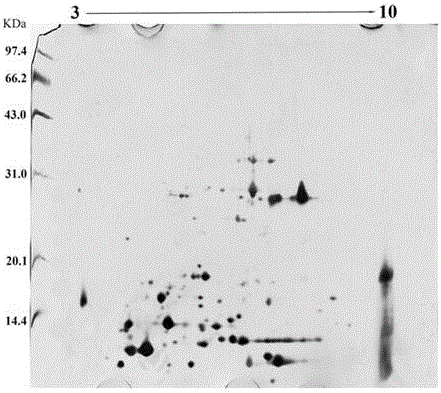Method for acquiring two-dimensional electrophoretogram of nectar protein of liriodendron tulipifera by aid of two-dimensional electrophoresis system
A technology of two-dimensional electrophoresis and electrophoresis, which is applied in the field of plant proteomics, can solve the problem of high-quality two-dimensional electrophoresis of samples without effective proteomics analysis, and achieve high protein extraction efficiency, optimized extraction process, and high resolution. Effect
- Summary
- Abstract
- Description
- Claims
- Application Information
AI Technical Summary
Problems solved by technology
Method used
Image
Examples
Embodiment 1
[0047] A method for obtaining the two-dimensional electrophoresis spectrum of the nectar protein of Liriodendron tulipifera by using a two-dimensional electrophoresis system, comprising the steps of:
[0048] (1) Preparation of protein samples from Liriodendron tulipifera nectar
[0049] During the period when Liriodendron tulipifolia secretes a lot of nectar and the flower buds are not open, carefully peel off the tepals, such as figure 1 As shown, the nectar was aspirated with a micropipette, then snap-frozen in liquid nitrogen and brought back. During the suction process, avoid the pipette tip from piercing the flower organ tissue, causing tissue fluid to contaminate the nectar.
[0050] Take 10 mL of Liriodendron tulipifera nectar stored at -80°C, put it on ice to melt, first filter the sample with an ultra-microfiltration membrane with a pore size of 0.22 μm, and then enrich and purify the protein in each Ultra-0.5 Centrifugal Filter 3K Add 500μL sample to the column, c...
Embodiment 2
[0066] The method for obtaining the two-dimensional electrophoresis spectrum of the nectar of Liriodendron tulipifera nectar using conventional protein extraction methods comprises the following steps:
[0067] (1) Preparation of protein samples from Liriodendron tulipifera nectar
[0068] During the period when Liriodendron tulipifolia secretes a lot of nectar and the flower buds are not open, carefully peel off the tepals, such as figure 1 As shown, the nectar was aspirated with a micropipette, then snap-frozen in liquid nitrogen and brought back. During the suction process, avoid the pipette tip from piercing the flower organ tissue, causing tissue fluid to contaminate the nectar.
[0069] Liriodendron tulipifera nectar proteins were extracted using the most commonly used conventional TCA-acetone method. Take 10 mL of Liriodendron tulipifera nectar stored at -80 °C, put it on ice to melt, add 3 times the volume of -20 °C pre-cooled 10% TCA solution (w / v) prepared in aceto...
PUM
| Property | Measurement | Unit |
|---|---|---|
| Aperture | aaaaa | aaaaa |
Abstract
Description
Claims
Application Information
 Login to View More
Login to View More - R&D
- Intellectual Property
- Life Sciences
- Materials
- Tech Scout
- Unparalleled Data Quality
- Higher Quality Content
- 60% Fewer Hallucinations
Browse by: Latest US Patents, China's latest patents, Technical Efficacy Thesaurus, Application Domain, Technology Topic, Popular Technical Reports.
© 2025 PatSnap. All rights reserved.Legal|Privacy policy|Modern Slavery Act Transparency Statement|Sitemap|About US| Contact US: help@patsnap.com



